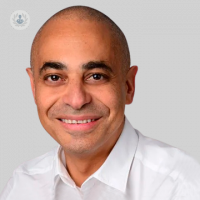Strabismus in children: When should parents worry?
Written by:When it comes to children's eye health, understanding conditions like strabismus is crucial for early detection and intervention. Strabismus, also known in the United Kingdom as “squint”, is a common ophthalmic condition that affects vision and eye movement.
Here, Mr Lloyd Bender, consultant adult and paediatric ophthalmologist in London, provides an expert insight into strabismus and also offers advice on when parents should seek medical attention for their child’s eye misalignment.

Is it common for infants to have occasional eye misalignment?
It's not uncommon for infants to exhibit occasional eye misalignment. In the early months of life, a baby's visual system is still developing, and the eye muscles may not always coordinate perfectly. However, persistent or worsening misalignment beyond the first 2 to 3 months of life could be indicative of strabismus.
How can I tell if my child has strabismus? What signs should I look for?
Detecting strabismus in children involves recognising specific signs and symptoms. Keep an eye out for:
- Visible ocular misalignment: Observe if one eye consistently turns inward, outward, upward, or downward.
- Squinting or closing one eye: Children who have strabismus may squint or close one eye to avoid double vision.
- Head tilting: Some children may tilt their head to find a more comfortable viewing angle.
- Poor depth perception: Strabismus can impact a child's ability to perceive depth accurately.
Prompt consultation with an ophthalmologist is crucial if parents notice persistent signs of strabismus in their child. Early detection allows for timely intervention and better outcomes. If parents observe consistent eye misalignment, squinting or similar behaviours, it’s important to schedule an eye examination for their child.
What are the potential causes of strabismus in children?
The causes of strabismus in children can vary, and there might be a genetic component involved. Factors contributing to strabismus include:
- Muscle imbalance: Weak or overactive eye muscles can lead to misalignment.
- Refractive errors: Farsightedness or other refractive issues may contribute to strabismus.
- Family history: If other family members have had strabismus, there may be a genetic predisposition.
How is strabismus clinically diagnosed?
Clinical diagnosis of strabismus involves a comprehensive eye examination conducted by an ophthalmologist. Tests and examinations may include:
- Cover test: Detects misalignment by observing how each eye focuses when the other is covered.
- Refraction test: Assesses if refractive errors contribute to strabismus.
- Visual acuity test: Evaluates the clarity of vision in each eye. Strabismus can be complicated by poor vision development in one eye, termed amblyopia.
- Ocular motility exam: Assesses the movement and coordination of the eye muscles.
Can strabismus in children be outgrown, or does it require intervention?
While some cases of infantile strabismus may improve on their own, persistent or worsening strabismus usually requires medical intervention.
Non-surgical treatment options for strabismus in children may include:
- Eyeglasses: Correcting refractive errors can help alleviate strabismus.
- Eye patches: Occlusion therapy may be prescribed.
- Treatment of amblyopia.
How is strabismus corrected with surgery?
In cases where non-surgical methods prove insufficient, strabismus correction through surgery may be recommended. The procedure is usually performed under general anaesthesia, as a day-case.
During strabismus surgery, the specialist will either move the muscle insertion farther back on the eyeball to weaken its action or, remove a portion of the muscle to strengthen its action. The specialist will then adjust the length, tension, or position of the eye muscles to achieve the desired alignment.
Strabismus surgery is often successful in improving eye alignment and function. However, individual outcomes can vary. Factors such as the type and severity of strabismus, the child's age, and adherence to postoperative care can influence the overall success.
Amblyopia, if present, will need to assessed and treated despite strabismus surgery.
How often should my child’s eyes be checked after strabismus treatment?
Regular follow-up appointments are essential after strabismus treatment. The frequency of check-ups depends on the specific case and the type of intervention. Typically, more frequent visits are scheduled immediately after surgery, gradually decreasing as the child's condition stabilises.
If you would like to book a consultation with Mr Bender, do not hesitate to do so by visiting his Top Doctors profile today.


